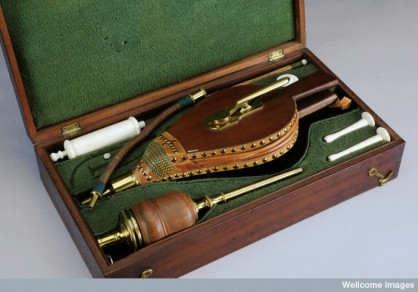It is? Examine it carefully. . . . .

Tobacco Smoke Enema Kit (1750’s – 1810’s).
The tobacco enema was used to infuse tobacco smoke into a patient’s rectum for various medical purposes, but primarily the resuscitation of drowning victims.
A rectal tube inserted into the anus was connected to a fumigator and bellows that forced the smoke into the rectum. The warmth of the smoke was thought to promote respiration. . .
Doubts about the credibility of tobacco enemas led to the popular phrase “Blowing Smoke Up Your A**.”
As you are most likely aware, this odd tool is still heavily used by all levels of government today.
~ Additional Research for Your Consideration ~
1. An old-school pharmacy hand-delivers drugs to Congress, a little-known perk for the powerful
2. U.S. Congress engineered DEA racket to protect Big Pharma’s opioid drug giants
L0057782 Resuscitation set, Europe, 1801-1850
The idea of reviving a victim of drowning by injecting tobacco smoke into the rectum or the lungs seems very strange to us. To some physicians working two hundred years ago, however, this approach was entirely rational. The resuscitation set contains the equipment necessary to inject into the lungs, stomach or rectum. The bellows could be adapted to inflate the lungs with fresh air or to introduce more stimulating vapors such as tobacco in an attempt to revive the patient. The set includes a small ivory syringe with a flexible leather tube to inject stimulants into the stomach. It also contains nozzles, small circular discs for the nostrils and, for the rectum, the long ivory tubes at the front of the set.
Credit: Science Museum, London.
Image: Wellcome Images
Maker: Unknown maker
Place made: Europe
Made (depicted model): 1801-1850

Dr. W.D. Kelley; woodcarving cir. 1974
FAIR USE NOTICE: This site contains copyrighted material the use of which has not always been specifically authorized by the copyright owner. We are making such material available in our efforts to advance understanding of environmental, political, human rights, economic, democracy, scientific, and social justice issues, etc. We believe this constitutes a ‘fair use’ of any such copyrighted material as provided for in section 107 of the US Copyright Law. In accordance with Title 17 U. S. C. Section 107, the material on this site is distributed without profit to those who have expressed a prior interest in receiving the included information for research and educational purposes. For more information go to: http://www.law.cornell.edu/uscode/17/107.shtml“
